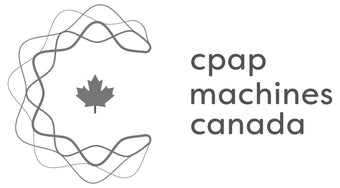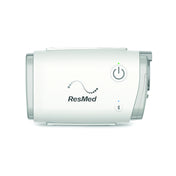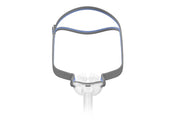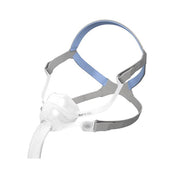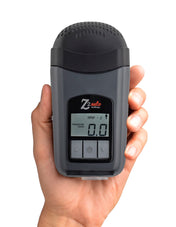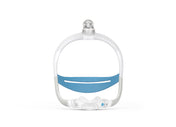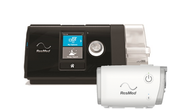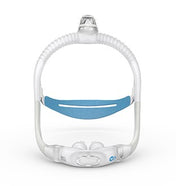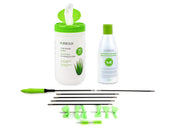Qu’est-ce que l’apnée du sommeil ?
L'apnée obstructive du sommeil est un trouble du sommeil potentiellement grave dans lequel la respiration s'arrête et redémarre à plusieurs reprises pendant le sommeil.
En savoir plus sur l'apnée du sommeil
Il existe plusieurs types d'apnée du sommeil, mais le plus courant est l'apnée obstructive du sommeil, qui survient lorsque les muscles de la gorge se relâchent par intermittence et obstruent les voies respiratoires pendant le sommeil. Le signe le plus visible de l'apnée obstructive du sommeil est le ronflement, même si toutes les personnes atteintes ne ronflent pas. Vous pouvez souffrir d'apnée du sommeil si vous ronflez bruyamment et que vous vous sentez fatigué même après une nuit complète de sommeil. Si vous pensez souffrir d'apnée du sommeil, consultez votre médecin. Un traitement est nécessaire pour éviter les problèmes cardiaques et autres complications.
L'apnée obstructive du sommeil peut être présente chez tout le monde, mais elle touche plus fréquemment les personnes âgées. Elle est également particulièrement fréquente chez les personnes en surpoids. Le traitement de l'apnée obstructive du sommeil peut impliquer l'utilisation d'un appareil de ventilation en pression positive continue (PPC) pour maintenir les voies respiratoires ouvertes ou une intervention chirurgicale pour retirer des tissus du nez, de la bouche ou de la gorge.

L'apnée obstructive du sommeil survient lorsque les muscles qui soutiennent les tissus mous de la gorge, comme la langue et le palais mou, se relâchent temporairement. Ce relâchement entraîne un rétrécissement ou une obstruction des voies respiratoires, et l'arrêt momentané de la respiration.
Symptômes de l'apnée du sommeil
L'apnée du sommeil peut affecter votre santé de multiples façons. Les symptômes peuvent être aussi courants que le ronflement pendant le sommeil ou extrêmes, comme l'endormissement au volant. Si vous souffrez de l’une des affections ci-dessous, parlez à votre médecin du diagnostic et des options de traitement de l’apnée du sommeil.
- S'endormir en conduisant
- Somnolence diurne excessive (hypersomnie)
- Ronflements bruyants
- Épisodes observés d'arrêt respiratoire pendant le sommeil
- Réveils brusques accompagnés d'essoufflement
- Réveil avec la bouche sèche ou un mal de gorge
- Mal de tête matinal
- Mictions fréquentes la nuit
- Difficulté à rester endormi (insomnie)
Quand consulter un médecin
Consultez un professionnel de la santé si vous ressentez, ou si votre partenaire observe, les symptômes suivants :
- Ronflement suffisamment fort pour perturber votre sommeil ou celui des autres
- Essoufflement qui vous réveille du sommeil
- Pauses intermittentes dans votre respiration pendant le sommeil
- Somnolence diurne excessive, qui peut vous amener à vous endormir pendant que vous travaillez, regardez la télévision ou même conduisez un véhicule
Beaucoup de gens ne pensent pas que le ronflement est le signe d'un problème potentiellement grave, et toutes les personnes atteintes d'apnée du sommeil ne ronflent pas. Cependant, n'hésitez pas à consulter votre médecin si vous ronflez bruyamment, surtout s'ils sont entrecoupés de périodes de silence. En cas d'apnée du sommeil, le ronflement est généralement plus fort lorsque vous dormez sur le dos et s'atténue lorsque vous vous tournez sur le côté. Consultez votre médecin si vous souffrez de troubles du sommeil qui vous rendent chroniquement fatigué, somnolent et irritable. Une somnolence diurne excessive (hypersomnie) peut être due à d'autres troubles, comme la narcolepsie.
Comment l’apnée du sommeil est-elle diagnostiquée ?
En savoir plus sur les tests de détection de l'apnée du sommeil
Polysomnographie nocturne. Lors de cet examen, vous êtes branché à un appareil qui surveille votre activité cardiaque, pulmonaire et cérébrale, votre respiration, les mouvements de vos bras et de vos jambes, ainsi que votre taux d'oxygène dans le sang pendant votre sommeil. Cela peut aider votre médecin à écarter d'autres affections, comme les mouvements périodiques des membres ou la narcolepsie, qui peuvent également provoquer une somnolence diurne excessive, mais nécessitent un traitement différent.
Oxymétrie. Cette méthode de dépistage utilise un petit appareil qui surveille et enregistre votre taux d'oxygène dans le sang pendant votre sommeil. Un simple manchon, posé sans douleur sur un doigt, permet de recueillir les données pendant la nuit dans un laboratoire du sommeil. Si vous souffrez d'apnée du sommeil, les résultats de ce test montreront souvent une baisse de votre taux d'oxygène dans le sang pendant les apnées, puis une augmentation au réveil.
Tests cardiorespiratoires portables. Dans certaines circonstances, votre médecin peut vous prescrire des tests à domicile pour diagnostiquer l'apnée du sommeil. Ces tests comprennent généralement une oxymétrie, une mesure du débit d'air et une analyse des schémas respiratoires. Votre médecin peut également vous orienter vers un ORL afin d'écarter toute obstruction anatomique du nez ou de la gorge.
Comment traite-t-on l’apnée du sommeil ?
Thérapies contre l'apnée du sommeil
Pression positive continue des voies respiratoires (PPC)
Si vous souffrez d'apnée du sommeil modérée à sévère, un appareil qui délivre de l'air comprimé à travers un masque placé sur votre nez pendant votre sommeil peut vous être bénéfique. Le type le plus courant est la pression positive continue (PPC). Avec ce traitement, la pression de l'air respiré est continue et légèrement supérieure à celle de l'air ambiant, ce qui suffit juste à maintenir vos voies respiratoires supérieures ouvertes. Cela prévient l'apnée et le ronflement.
Bien que la PPC soit la méthode la plus efficace et la plus couramment utilisée pour traiter l'apnée du sommeil, certaines personnes la trouvent encombrante et inconfortable. Avec un peu de pratique, la plupart des gens apprennent à ajuster le masque pour un ajustement confortable et sûr. Il peut être nécessaire d'essayer différents types de masque pour trouver celui qui vous convient. Si vous avez des difficultés à supporter la pression, il existe des appareils dotés de fonctions d'adaptation de la pression pour améliorer votre confort. L'utilisation d'un humidificateur en complément de leur système PPC peut également être bénéfique.
N'arrêtez pas d'utiliser votre appareil CPAP si vous rencontrez des problèmes. Consultez votre médecin pour savoir comment améliorer votre confort. De plus, contactez-le si vous ronflez encore malgré le traitement ou si vous recommencez à ronfler. Si votre poids change, votre médecin pourrait être amené à ajuster les réglages de pression.
Embout buccal (dispositif buccal)
Chirurgie ou autres interventions
L’objectif de la chirurgie pour l’apnée du sommeil est d’éliminer l’excès de tissu de votre nez ou de votre gorge qui peut vibrer et vous faire ronfler, ou qui peut bloquer vos voies respiratoires supérieures et provoquer une apnée du sommeil.
